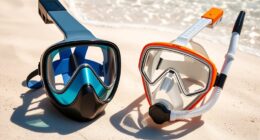To find your perfect paddle length with math, start by measuring your height accurately. For stand-up paddling, add between 8-12 inches to your height. For kayaking, choose a paddle that reaches between your chin and nose. Consider your paddling style and water conditions too. Using these simple calculations, you’ll select a paddle that feels natural and efficient. Keep going to discover how to fine-tune your choice for ideal comfort and performance.
Key Takeaways
- Measure your height accurately and add 8-12 inches for stand-up paddleboarding to determine ideal paddle length.
- For kayaking, select a paddle that reaches between your chin and nose for optimal comfort and efficiency.
- Consider your paddling style and watercraft type to refine the mathematical calculation for a better fit.
- Choose lightweight materials like carbon fiber or fiberglass to allow for longer paddles that reduce fatigue.
- Balance ergonomic factors with calculated length and use data analysis or AI tools for personalized paddle sizing.

Finding the right paddle length is vital for maximizing your performance and comfort on the water. When selecting a paddle, you need to consider various factors, including ergonomics considerations and paddle material options. Proper ergonomics ensure that your paddling motion feels natural, reducing fatigue and preventing strain. The right length allows your arms to move comfortably and efficiently, enabling you to generate more power with less effort. Ignoring ergonomics can lead to discomfort, soreness, and even injury over time, so it’s essential to choose a paddle that fits your body size and paddling style.
One of the most effective ways to determine the ideal paddle length is by applying simple math based on your height and the type of watercraft you’re using. For example, if you’re paddling a stand-up paddleboard, a common rule of thumb is to add 8-12 inches to your height. If you’re on a kayak, the paddle should generally reach somewhere between your chin and your nose when you hold it vertically with one hand. By measuring your height accurately and considering the paddle’s intended use, you can calculate an appropriate length that aligns with ergonomic considerations. This mathematical approach helps eliminate guesswork and guarantees you select a paddle that supports comfortable paddling mechanics.
Additionally, advancements in AI technology are increasingly being integrated into paddle design, offering opportunities for custom fitting and enhanced performance through data analysis. Paddle material options also influence your choice. Different materials offer varying levels of stiffness, weight, and durability, all of which impact the ideal paddle length. For instance, lightweight materials like carbon fiber or fiberglass allow for longer paddles without adding excessive weight, making them ideal for extended paddling sessions where fatigue can set in. Aluminum paddles, being heavier, might be better suited for shorter, casual outings and may require a slightly shorter length to maintain comfort. When you consider the paddle material options alongside ergonomics considerations, you can select a paddle that not only fits your body but also matches your paddling style and the conditions you’ll face on the water.
Ultimately, choosing the perfect paddle length involves balancing these factors. Using math to determine the right length based on your height and the type of watercraft ensures a precise fit, while understanding paddle material options helps you pick a paddle that’s comfortable and durable. By paying close attention to ergonomics considerations, you’ll find a paddle that enhances your efficiency and enjoyment on the water. This methodical approach makes your paddling experience more comfortable, effective, and enjoyable, helping you get the most out of every trip.
Frequently Asked Questions
How Does Paddle Length Affect Paddle Speed?
Paddle length directly impacts your paddle speed by influencing leverage and stroke efficiency. A longer paddle can generate more power, but may slow down your cadence, while a shorter one allows quicker strokes. Paddle material affects weight and responsiveness, and grip ergonomics ensure comfort, helping you maintain control. When choosing, consider how these factors work together to optimize your paddle speed, matching your style and conditions for better performance.
Can a Longer Paddle Improve My Paddle Stroke Technique?
A longer paddle can improve your stroke technique by providing more leverage and power. It allows you to engage your core better and reach further with each stroke. Make sure it has an ergonomic grip for comfort and control, reducing fatigue. Also, consider paddle material; lightweight options like carbon fiber make maneuvering easier, helping you refine your technique while reducing strain. A well-chosen, longer paddle enhances efficiency and performance.
What Is the Ideal Paddle Length for Beginners?
Did you know that most beginners pick paddles that are too long, making their stroke less efficient? For beginners, an ideal paddle length usually falls between chin and nose height, providing better control and comfort. Look for a paddle with an ergonomic grip for less fatigue, and choose lightweight paddle material for easier maneuvering. This combo helps you develop good technique without straining, setting a solid foundation for your paddling journey.
How Do Different Paddle Lengths Influence Arm Fatigue?
Different paddle lengths impact arm fatigue by affecting your leverage and control. A longer paddle increases reach but may cause you to strain your arm muscles more, especially if the paddle weight and ergonomic grip aren’t well-suited to you. Conversely, a shorter paddle reduces fatigue, offering better maneuverability. Always choose a paddle that balances weight and grip comfort, helping you stay energized and prevent fatigue during extended use.
Is There a Recommended Paddle Length for Specific Water Conditions?
Ever wondered if water conditions demand a specific paddle length? For rough water, you might prefer a longer paddle for better leverage, while calm conditions could call for a shorter one. Always consider your ergonomic grip and paddle material, as these influence comfort and efficiency. A longer paddle in turbulent water helps stabilize your stroke, but make certain it fits your height and strength. Wouldn’t you want a paddle that adapts perfectly to your environment?
Conclusion
Now that you know how to calculate your ideal paddle length, you’re ready to make a confident choice. Think of your paddle as an extension of yourself, perfectly balanced and tailored to your game. When you pick the right length, every stroke flows smoothly like a well-oiled machine. So, trust the math, embrace your perfect fit, and let your paddle be the key to opening your full potential on the water.










